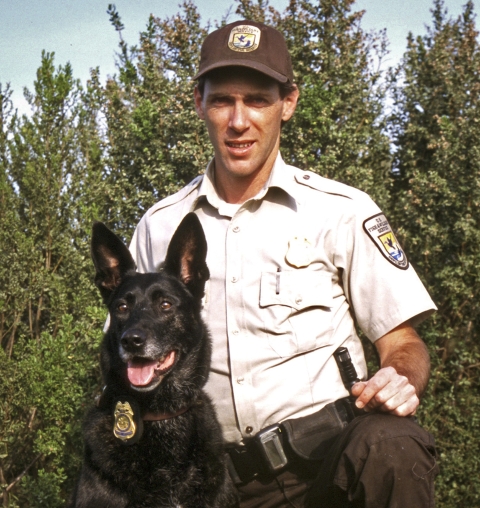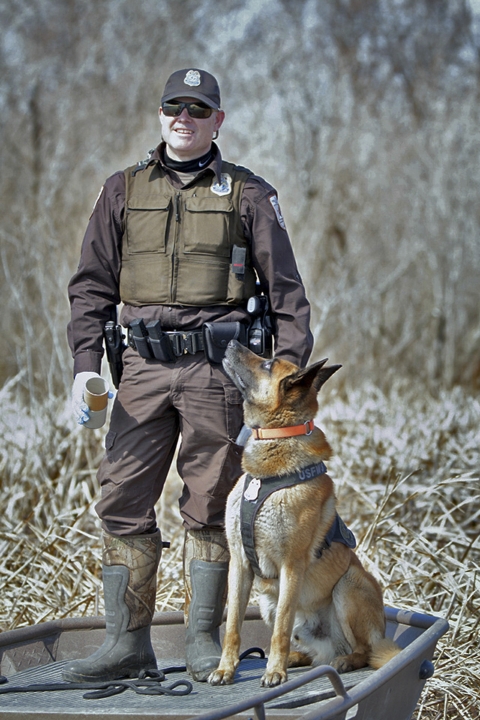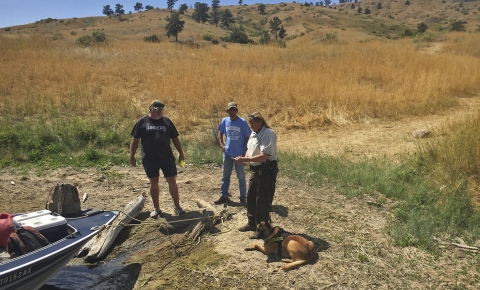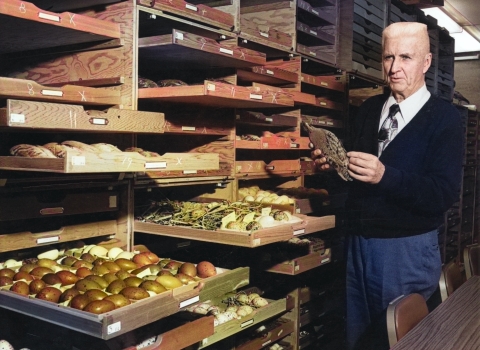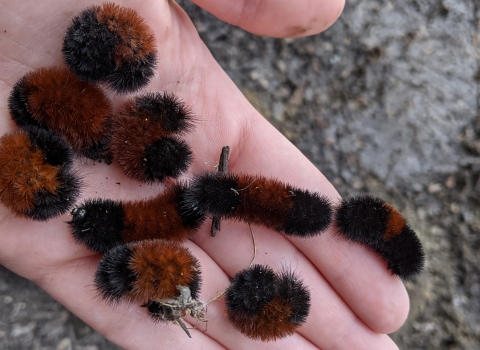Whether it is on a national wildlife refuge national wildlife refuge
A national wildlife refuge is typically a contiguous area of land and water managed by the U.S. Fish and Wildlife Service for the conservation and, where appropriate, restoration of fish, wildlife and plant resources and their habitats for the benefit of present and future generations of Americans.
Learn more about national wildlife refuge or a warehouse at an international airport, “man’s best friend,” is making a difference for the U.S Fish and Wildlife Service.
The K-9 program for refuges, which started in the Pacific Southwest Region in California 17 years ago, now has teams across five regions of the country doing everything from detection of wildlife and drugs to protection, sometimes serving a dual purpose.
“When I started working for the U.S. Fish and Wildlife Service as a law enforcement officer, I thought a dog would be tremendously helpful finding evidence and contraband due to their unbelievable ability to smell,” said Anthony Merrill, regional chief of refuge law enforcement for the Pacific Southwest Region in California who did a full year of research and was approved for the first ever fully accredited police dogs put in service in 2000. “It was definitely a new frontier.”
“Anthony was one of two officers who were really pioneers in bringing K-9s to refuges,” said Darryn Witt, national canine coordinator for the U.S. Fish and Wildlife Service since July 2016. “He helped pave the way for this program. It has evolved into a national program now and we got together as a group for the first time this past May for continuity. Our K-9s are premium locating tools. We benefit from their outstanding noses in many ways.”
The K-9s are very useful in case law.
“A dog sniff (today) is not considered a search so you don’t need a warrant,” said Merrill whose dogs have assisted with finding Alzheimer patients that have gotten lost. “Their sense of smell is simply incredible and if you can tap into that ability that is where the efficiency as far as getting your work done comes into play. Their hearing is helpful also. Being tuned into your K-9 partner increases your safety. Their senses that are so much more refined and fine-tuned than ours - a good K-9 team can have a very different impact on life or death situations.”
The Office of Law Enforcement also has K-9s including wildlife inspector and canine handler Raymond Hernandez in Torrance, California who does searches at the airports, sea ports and the border.
Hernandez has found his dog Lockett, extremely valuable.
“It’s almost as if they have x-ray vision,” he said. “Just imagine being able to look inside everyone’s luggage or cargo and pinpoint that one item that is illegal. A warehouse that I can clear in 30 minutes with her, would take me a year by myself. I can tell by her demeanor and posture right away whether or not we are going to find something. When you go into a room and smell soup; Lockett goes into the same room and knows every ingredient that went into that soup. She can smell reptiles in boxes being shipped due to the smell of them defecating or urinating in that box.
“We are essentially looking at shipments that are declared as pillows for example that turn out to be ivory handled swords or snake skinned shoes," he said. "We’re looking for the bad guys that are intentionally trying to squeeze something by.”
This also includes live wildlife such as turtles or snakes recently being imported or exported out of the country.
Besides detection, K-9s are also used for protection with different training specific to their areas of expertise. Breeds used included Belgian Malinois, German, Belgian and Dutch shepherds, some Labradors and springer spaniels. Detection dogs include narcotics and illegal wildlife.
Training is typically reward based. Similar to animals that like to play fetch, the training for K-9s is not that much different than when an owner teaches their dog to sit or stand – obedience training with hand signals and voice commands.
“A kind word or a pat on the head when playing fetch with your dog, and they will work their butt off for you,” said Merrill. “It is like training them to go after their prey for the detection dogs while protection K-9s requires them to be willing to get into a scuffle, though they rarely need to bite a suspect.”
Hernandez concurred: “She loves what she does,” he said of Lockett. “She loves me and I love her. She wants to please me, so she is working hard to find those things.”
Merrill believes the Service’s reputation has been greatly enhanced by the use of K-9s, many of whom are cross trained.
FINDING A SUSPECT
One of many memorable situations for Merrill where his K-9 helped local police was back in the summer of 2002. A suspect, who was wanted for armed robbery of a strawberry stand, exchanged gunfire with local officers in Merced, fled the scene, abandoned his stolen car and vanished.
With a perimeter set up, helicopter deployed and SWAT team on the scene, local officers still could not find the suspect. Enter Merrill and his K-9: Brenda who were contacted by dispatch due to such a high success rate. Merrill wiped the steering wheel and seat to get as much scent from the stolen car and let Brenda smell it.
“It’s like their version of a booking photo or wanted poster except their basing it off scent instead of sight,” said Merrill.
Brenda tracked the scent to a house and then a walking trail where there was a creek when Merrill noticed there was a change in his dog – he knew they were getting close.
“It’s like when a hunting dog finds a pheasant or a duck, you can tell their behavior is changing,” he said.
Merrill took Brenda off the lead and let her work on her own. “That is the most safe I’ve felt,” he said of the SWAT behind him and his dog. After searching for a while, Brenda started barking indicating that she found the suspect.
“He was laying on his back in the water almost completely submerged in cat tails and blackberry bushes and started yelling ‘get the dog away, I give up, I give up,’ and we were able to get him into custody without any injuries,” said Merrill.
“Later during an interview with investigators the suspect said he could see the SWAT team but was only concerned about the dog. That could have saved a number of lives that day.
“I have never gotten into a physical altercation with a suspect since I had a K-9,” said Merrill. “They not only kept me safe, but they reduce the likelihood of more critical injury to dangerous suspects also. The focus goes off of the officer and onto the K-9 and that extra couple of seconds means everything. It is a really good non-lethal option and the only option you can call back once you’ve deployed it. Once you shoot or deploy a Taser there’s no calling it back.”
Witt agreed: “It is a great deterrent – just the presence of a K-9,” he said. “As federal wildlife officers we use a lot of equipment to protect ourselves and others but there is no substitute for the K-9s when it comes to officer protection and how good they are at that. Our backup might be a couple of hours away so to have the dog there with you for your safety is a real benefit.”
ENFORCING REGULATIONS
On one mission, Witt was tracking a notorious poaching group in the upper Mississippi. He had attempted to catch them with extra waterfowl for three years.
One day, he saw three men from the group shoot their limit in ducks, stashing the birds at three different locations. Watching with binoculars, Witt saw them move the birds and go back to shooting more ducks. He took his K-9 Rudy and he located the ducks immediately.
“That’s a case I never would have made without Rudy,” said Witt.
In another situation, Witt was trying to arrest a felon for battery – someone who was known to fight police officers. Witt told the suspect he needed to put handcuffs on him or he would be “wearing my dog.”
“He took one look at me and then Rudy and then walked up with his hands behind his back,” said Witt. “He might have been interested in fighting me, but he sure wasn’t interested in fighting Rudy.”
SEARCHING WAREHOUSES
For Hernandez, his most unique search involved a specific container at a warehouse where they usually find televisions or clothes. Upon their search, all of a sudden Lockett whipped her head around as if she sensed something. Upon opening the container in question, Hernandez found artifacts from Papua New Guinea including swords and shields made from animal parts. They also found reptile products.
While Hernandez “isn’t typically grossed out” by what he sees, and often doesn’t usually wear gloves, he related one instance with a surprising outcome. One day during a search of incoming packages, and while having a conversation with a Customs and Border Patrol supervisor, he reached into a box and he froze; his face turned white. “My hand came in contact with a human skull,” he said. The four skulls he found were actually were effigies over-molded using clay and hair.
Wildlife officer, Deb Goeb, checks licensing information with her canine partner, Lex, at the Charles M. Russell National Wildlife Refuge, in Montana. Credit: USFWS
The artifacts can fetch anywhere from $4,000-$15,000 on the black market.
PROTECTING WILDLIFE
The heroic K-9 stories go on and on. Such as Deb Goeb, a wildlife officer at Charles M. Russell National Wildlife Refuge whose K-9 was able to locate a rifle stashed in sagebrush sagebrush
The western United States’ sagebrush country encompasses over 175 million acres of public and private lands. The sagebrush landscape provides many benefits to our rural economies and communities, and it serves as crucial habitat for a diversity of wildlife, including the iconic greater sage-grouse and over 350 other species.
Learn more about sagebrush from a subject that illegally shot a bighorn sheep.
"Lex goes where I go and Lex is out of the vehicle, at my side when I'm out of the vehicle making visitor contacts," she said. "Lex patrols by boat, foot, truck and ATV."
Of course there is a deep bond typically between refuge K-9s and their handlers who spend all day with each other and then go home together.
“They’re not like a gun belt that you can just take off at the end of your shift and throw in a closet,” said Merrill. “They are a part of your family.”

